2007 ISUZU KB P190 EGR
[x] Cancel search: EGRPage 1818 of 6020
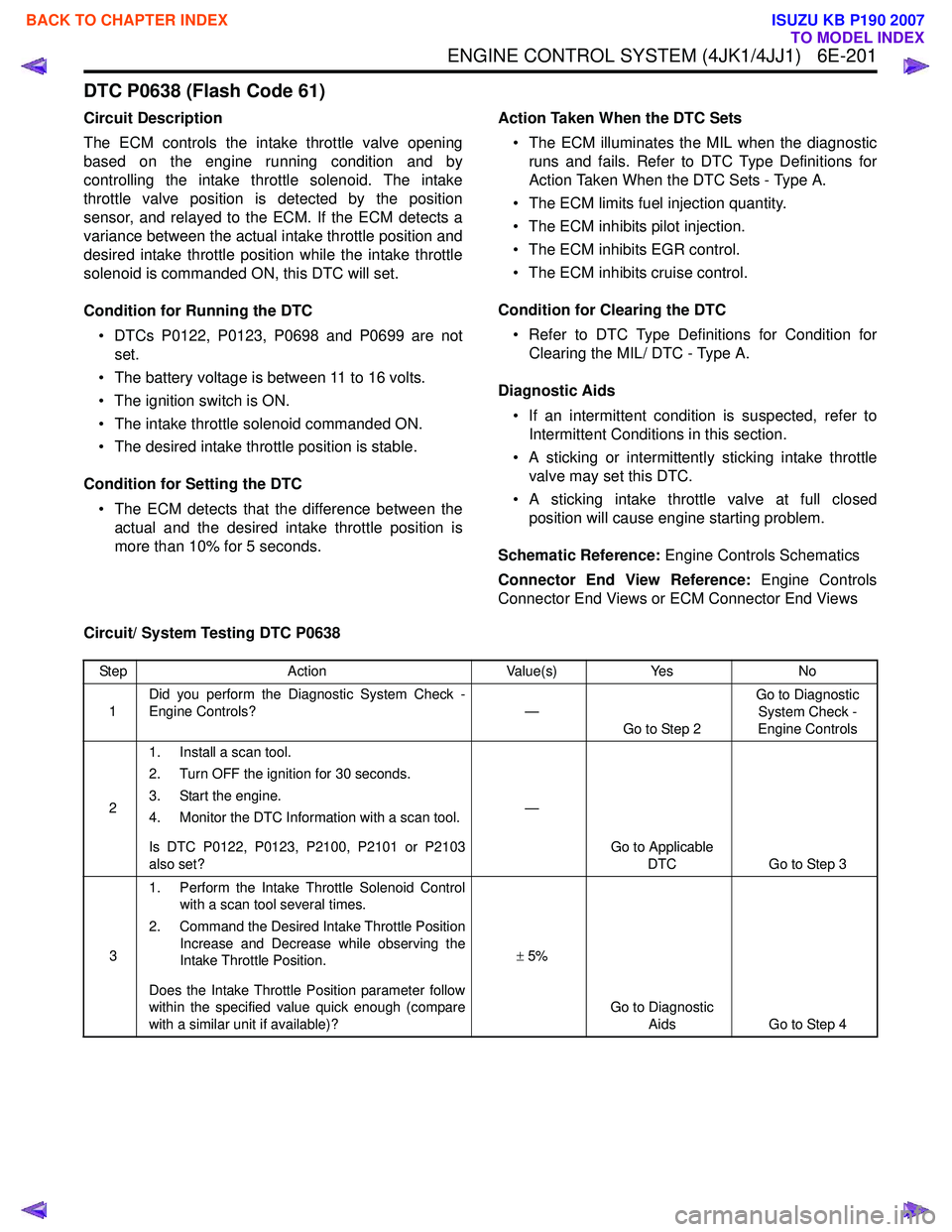
ENGINE CONTROL SYSTEM (4JK1/4JJ1) 6E-201
DTC P0638 (Flash Code 61)
Circuit Description
The ECM controls the intake throttle valve opening
based on the engine running condition and by
controlling the intake throttle solenoid. The intake
throttle valve position is detected by the position
sensor, and relayed to the ECM. If the ECM detects a
variance between the actual intake throttle position and
desired intake throttle position while the intake throttle
solenoid is commanded ON, this DTC will set.
Condition for Running the DTC • DTCs P0122, P0123, P0698 and P0699 are not set.
• The battery voltage is between 11 to 16 volts.
• The ignition switch is ON.
• The intake throttle solenoid commanded ON.
• The desired intake throttle position is stable.
Condition for Setting the DTC • The ECM detects that the difference between the actual and the desired intake throttle position is
more than 10% for 5 seconds. Action Taken When the DTC Sets
• The ECM illuminates the MIL when the diagnostic runs and fails. Refer to DTC Type Definitions for
Action Taken When the DTC Sets - Type A.
• The ECM limits fuel injection quantity.
• The ECM inhibits pilot injection.
• The ECM inhibits EGR control.
• The ECM inhibits cruise control.
Condition for Clearing the DTC • Refer to DTC Type Definitions for Condition for Clearing the MIL/ DTC - Type A.
Diagnostic Aids • If an intermittent condition is suspected, refer to Intermittent Conditions in this section.
• A sticking or intermittently sticking intake throttle valve may set this DTC.
• A sticking intake throttle valve at full closed position will cause engine starting problem.
Schematic Reference: Engine Controls Schematics
Connector End View Reference: Engine Controls
Connector End Views or ECM Connector End Views
Circuit/ System Testing DTC P0638
Step Action Value(s)Yes No
1 Did you perform the Diagnostic System Check -
Engine Controls? —
Go to Step 2 Go to Diagnostic
System Check -
Engine Controls
2 1. Install a scan tool.
2. Turn OFF the ignition for 30 seconds.
3. Start the engine.
4. Monitor the DTC Information with a scan tool.
Is DTC P0122, P0123, P2100, P2101 or P2103
also set? —
Go to Applicable DTC Go to Step 3
3 1. Perform the Intake Throttle Solenoid Control
with a scan tool several times.
2. Command the Desired Intake Throttle Position Increase and Decrease while observing the
Intake Throttle Position.
Does the Intake Throttle Position parameter follow
within the specified value quick enough (compare
with a similar unit if available)? ±
5%
Go to Diagnostic Aids Go to Step 4
BACK TO CHAPTER INDEX
TO MODEL INDEX
ISUZU KB P190 2007
Page 1826 of 6020
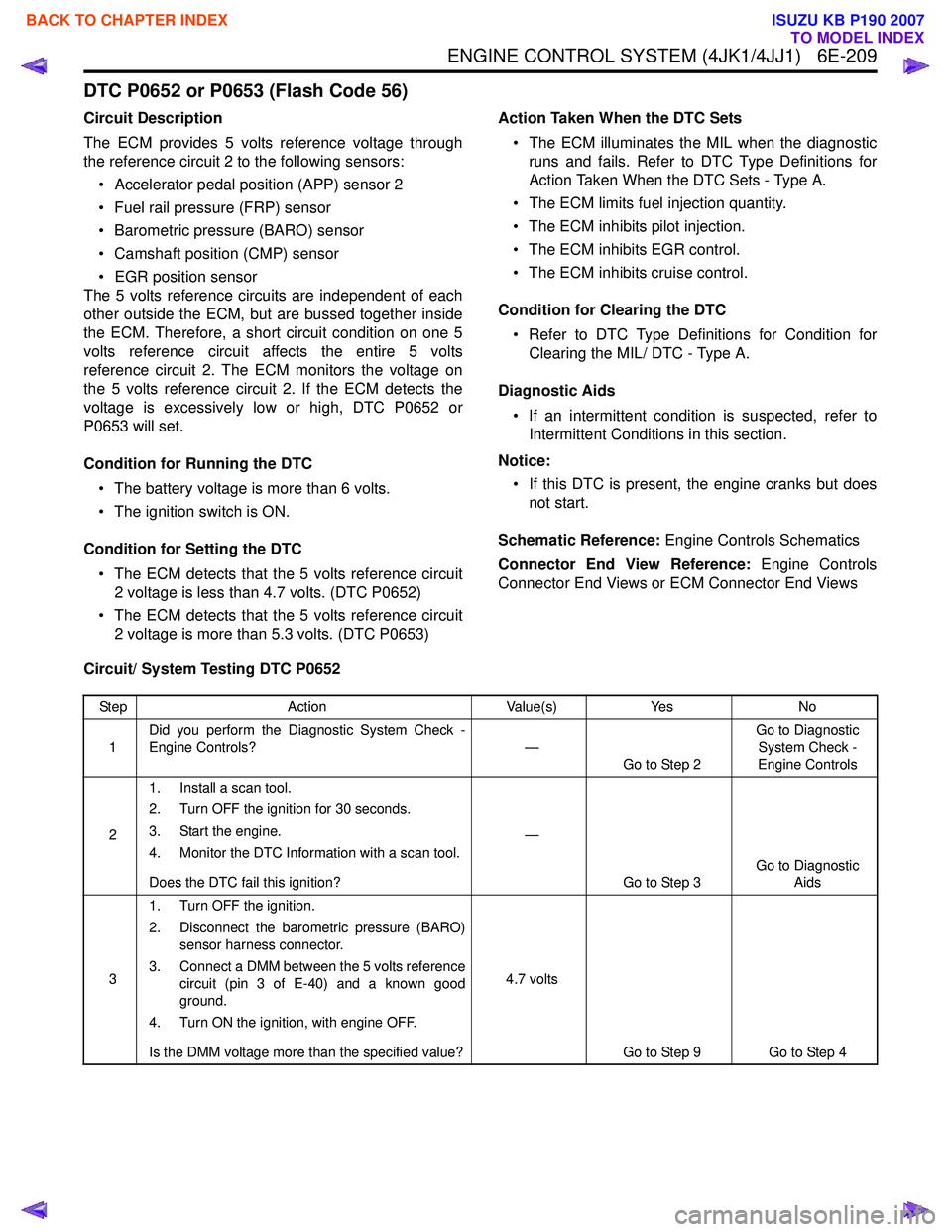
ENGINE CONTROL SYSTEM (4JK1/4JJ1) 6E-209
DTC P0652 or P0653 (Flash Code 56)
Circuit Description
The ECM provides 5 volts reference voltage through
the reference circuit 2 to the following sensors:
• Accelerator pedal position (APP) sensor 2
• Fuel rail pressure (FRP) sensor
• Barometric pressure (BARO) sensor
• Camshaft position (CMP) sensor
• EGR position sensor
The 5 volts reference circuits are independent of each
other outside the ECM, but are bussed together inside
the ECM. Therefore, a short circuit condition on one 5
volts reference circuit affects the entire 5 volts
reference circuit 2. The ECM monitors the voltage on
the 5 volts reference circuit 2. If the ECM detects the
voltage is excessively low or high, DTC P0652 or
P0653 will set.
Condition for Running the DTC • The battery voltage is more than 6 volts.
• The ignition switch is ON.
Condition for Setting the DTC • The ECM detects that the 5 volts reference circuit 2 voltage is less than 4.7 volts. (DTC P0652)
• The ECM detects that the 5 volts reference circuit 2 voltage is more than 5.3 volts. (DTC P0653) Action Taken When the DTC Sets
• The ECM illuminates the MIL when the diagnostic runs and fails. Refer to DTC Type Definitions for
Action Taken When the DTC Sets - Type A.
• The ECM limits fuel injection quantity.
• The ECM inhibits pilot injection.
• The ECM inhibits EGR control.
• The ECM inhibits cruise control.
Condition for Clearing the DTC • Refer to DTC Type Definitions for Condition for Clearing the MIL/ DTC - Type A.
Diagnostic Aids • If an intermittent condition is suspected, refer to Intermittent Conditions in this section.
Notice: • If this DTC is present, the engine cranks but does not start.
Schematic Reference: Engine Controls Schematics
Connector End View Reference: Engine Controls
Connector End Views or ECM Connector End Views
Circuit/ System Testing DTC P0652
Step Action Value(s)Yes No
1 Did you perform the Diagnostic System Check -
Engine Controls? —
Go to Step 2 Go to Diagnostic
System Check -
Engine Controls
2 1. Install a scan tool.
2. Turn OFF the ignition for 30 seconds.
3. Start the engine.
4. Monitor the DTC Information with a scan tool.
Does the DTC fail this ignition? —
Go to Step 3 Go to Diagnostic
Aids
3 1. Turn OFF the ignition.
2. Disconnect the barometric pressure (BARO) sensor harness connector.
3. Connect a DMM between the 5 volts reference circuit (pin 3 of E-40) and a known good
ground.
4. Turn ON the ignition, with engine OFF.
Is the DMM voltage more than the specified value? 4.7 volts
Go to Step 9 Go to Step 4
BACK TO CHAPTER INDEX
TO MODEL INDEX
ISUZU KB P190 2007
Page 1827 of 6020

6E-210 ENGINE CONTROL SYSTEM (4JK1/4JJ1)
41. Leave the DMM connected to the BARO
sensor harness connector.
2. Turn OFF the ignition.
3. Disconnect the EGR valve harness connector.
4. Turn ON the ignition, with the engine OFF.
Does the DMM voltage change to more than the
specified value? 4.7 volts
Go to Step 10 Go to Step 5
5 1. Leave the DMM connected to the BARO
sensor harness connector.
2. Turn OFF the ignition.
3. Disconnect the fuel rail pressure (FRP) sensor harness connector.
4. Turn ON the ignition, with the engine OFF.
Does the DMM voltage change to more than the
specified value? 4.7 volts
Go to Step 11 Go to Step 6
6 1. Leave the DMM connected to the BARO
sensor harness connector.
2. Turn OFF the ignition.
3. Disconnect the camshaft position (CMP) sensor harness connector.
4. Turn ON the ignition, with the engine OFF.
Does the DMM voltage change to more than the
specified value? 4.7 volts
Go to Step 12 Go to Step 7
7 1. Leave the DMM connected to the BARO
sensor harness connector.
2. Turn OFF the ignition.
3. Disconnect the accelerator pedal position (APP) sensor harness connector.
4. Turn ON the ignition, with the engine OFF.
Does the DMM voltage change to more than the
specified value? 4.7 volts
Go to Step 13 Go to Step 8
8 1. Test the 5 volts reference circuit between the
ECM and the following components for a short
to ground or short to the low reference circuit:
• ECM (pin 19 of E-90) and BARO sensor (pin 3 of E-40)
• ECM (pin 31 of E-90) and EGR position sensor (pin 1 of E-71)
• ECM (pin 47 of E-90) and FRP sensor (pin 3 of E-48)
• ECM (pin 46 of E-90) and CMP sensor (pin 3 of E-39)
• ECM (pin 9 of C-58) and APP sensor 2 (pin 8 of C-40)
2. Repair the circuit(s) as necessary.
Did you find and correct the condition? —
Go to Step 15 Go to Step 14
9 Replace the BARO sensor. Refer to BARO Sensor
Replacement.
Did you complete the replacement? —
Go to Step 15
—
10Replace the EGR valve. Refer to EGR Valve
Replacement.
Did you complete the replacement? —
Go to Step 15
—
Step Action Value(s)Yes No
BACK TO CHAPTER INDEX
TO MODEL INDEX
ISUZU KB P190 2007
Page 1829 of 6020
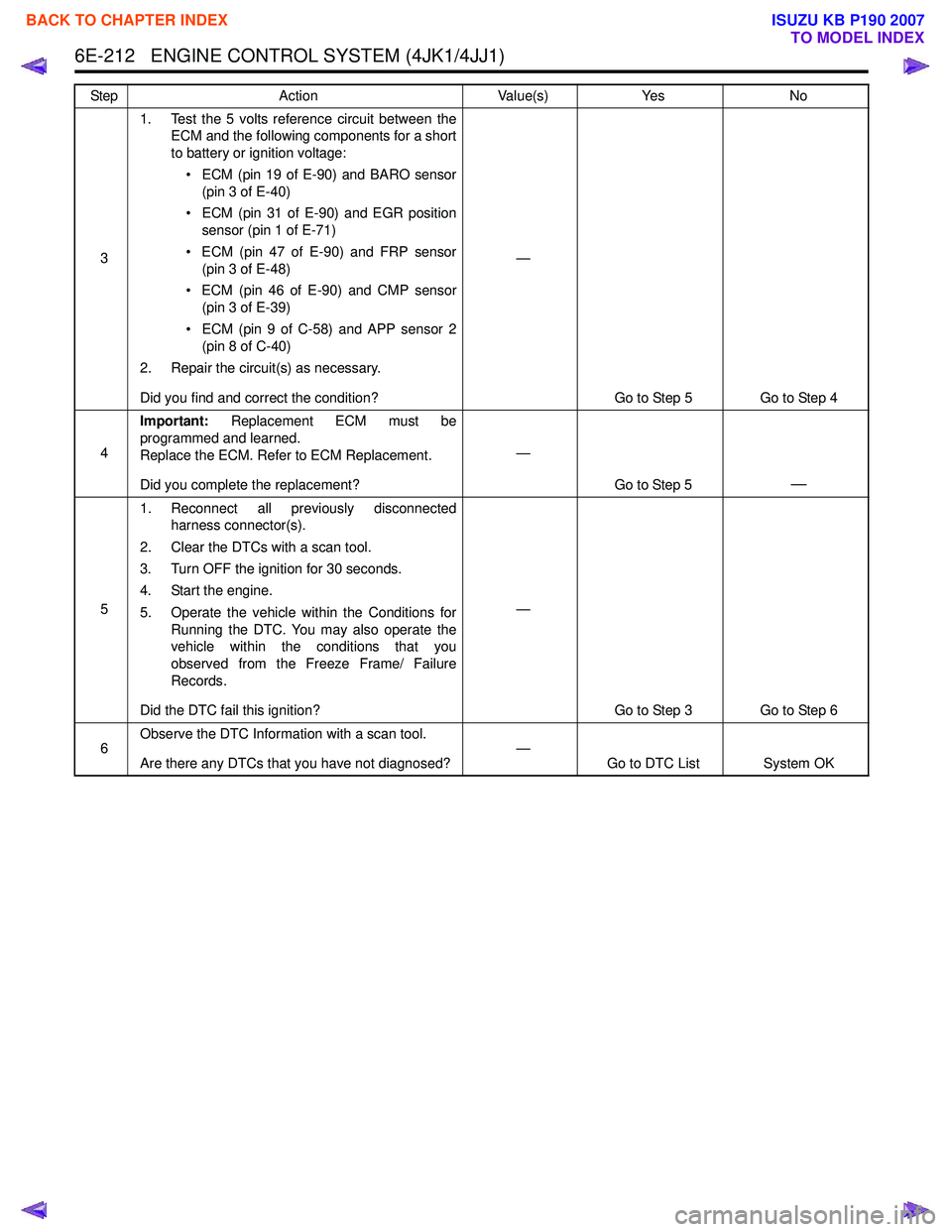
6E-212 ENGINE CONTROL SYSTEM (4JK1/4JJ1)
31. Test the 5 volts reference circuit between the
ECM and the following components for a short
to battery or ignition voltage:
• ECM (pin 19 of E-90) and BARO sensor (pin 3 of E-40)
• ECM (pin 31 of E-90) and EGR position sensor (pin 1 of E-71)
• ECM (pin 47 of E-90) and FRP sensor (pin 3 of E-48)
• ECM (pin 46 of E-90) and CMP sensor (pin 3 of E-39)
• ECM (pin 9 of C-58) and APP sensor 2 (pin 8 of C-40)
2. Repair the circuit(s) as necessary.
Did you find and correct the condition? —
Go to Step 5 Go to Step 4
4 Important:
Replacement ECM must be
programmed and learned.
Replace the ECM. Refer to ECM Replacement.
Did you complete the replacement? —
Go to Step 5
—
51. Reconnect all previously disconnected
harness connector(s).
2. Clear the DTCs with a scan tool.
3. Turn OFF the ignition for 30 seconds.
4. Start the engine.
5. Operate the vehicle within the Conditions for Running the DTC. You may also operate the
vehicle within the conditions that you
observed from the Freeze Frame/ Failure
Records.
Did the DTC fail this ignition? —
Go to Step 3 Go to Step 6
6 Observe the DTC Information with a scan tool.
Are there any DTCs that you have not diagnosed? —
Go to DTC List System OK
Step
Action Value(s)Yes No
BACK TO CHAPTER INDEX
TO MODEL INDEX
ISUZU KB P190 2007
Page 1834 of 6020
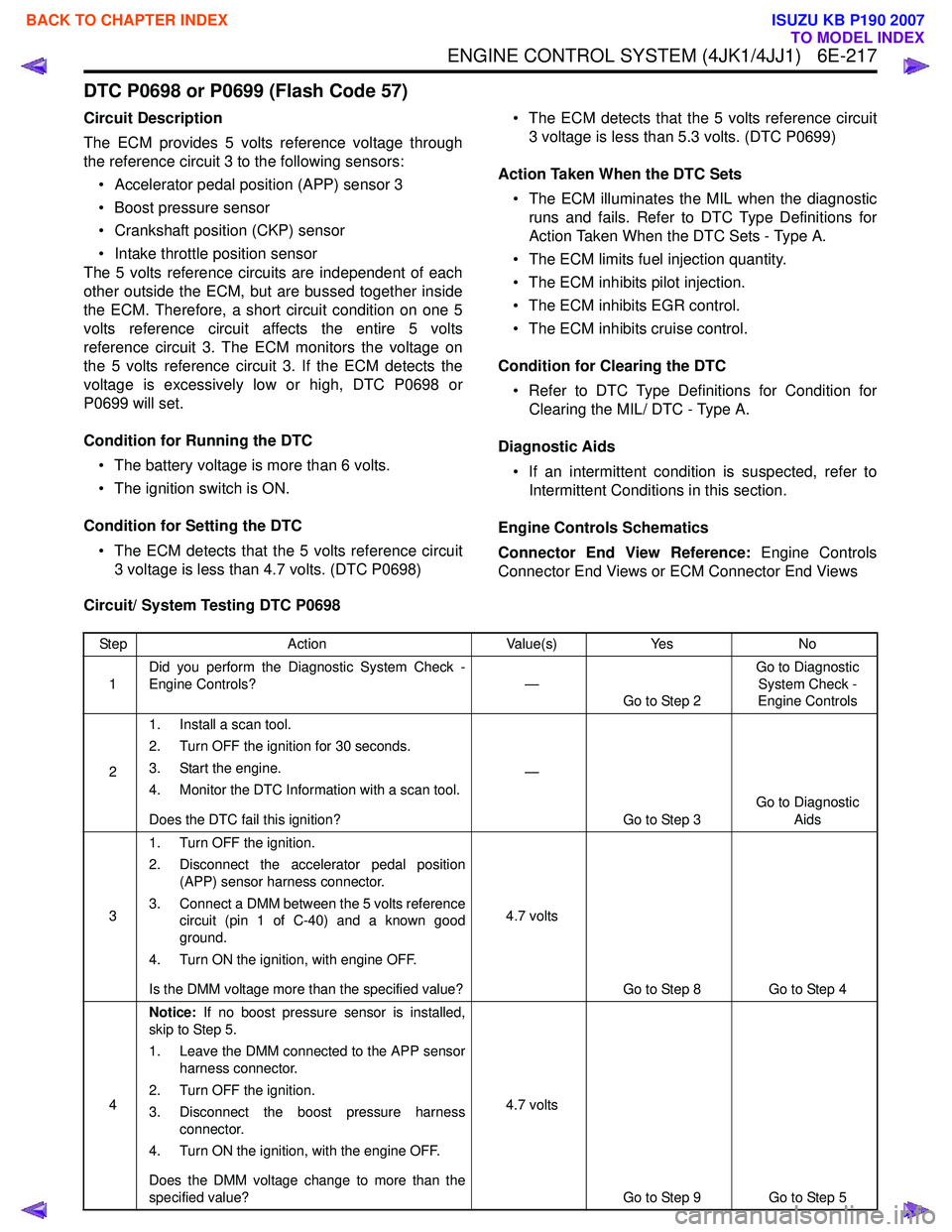
ENGINE CONTROL SYSTEM (4JK1/4JJ1) 6E-217
DTC P0698 or P0699 (Flash Code 57)
Circuit Description
The ECM provides 5 volts reference voltage through
the reference circuit 3 to the following sensors:
• Accelerator pedal position (APP) sensor 3
• Boost pressure sensor
• Crankshaft position (CKP) sensor
• Intake throttle position sensor
The 5 volts reference circuits are independent of each
other outside the ECM, but are bussed together inside
the ECM. Therefore, a short circuit condition on one 5
volts reference circuit affects the entire 5 volts
reference circuit 3. The ECM monitors the voltage on
the 5 volts reference circuit 3. If the ECM detects the
voltage is excessively low or high, DTC P0698 or
P0699 will set.
Condition for Running the DTC • The battery voltage is more than 6 volts.
• The ignition switch is ON.
Condition for Setting the DTC • The ECM detects that the 5 volts reference circuit 3 voltage is less than 4.7 volts. (DTC P0698) • The ECM detects that the 5 volts reference circuit
3 voltage is less than 5.3 volts. (DTC P0699)
Action Taken When the DTC Sets • The ECM illuminates the MIL when the diagnostic runs and fails. Refer to DTC Type Definitions for
Action Taken When the DTC Sets - Type A.
• The ECM limits fuel injection quantity.
• The ECM inhibits pilot injection.
• The ECM inhibits EGR control.
• The ECM inhibits cruise control.
Condition for Clearing the DTC • Refer to DTC Type Definitions for Condition for Clearing the MIL/ DTC - Type A.
Diagnostic Aids • If an intermittent condition is suspected, refer to Intermittent Conditions in this section.
Engine Controls Schematics
Connector End View Reference: Engine Controls
Connector End Views or ECM Connector End Views
Circuit/ System Testing DTC P0698
Step Action Value(s)Yes No
1 Did you perform the Diagnostic System Check -
Engine Controls? —
Go to Step 2 Go to Diagnostic
System Check -
Engine Controls
2 1. Install a scan tool.
2. Turn OFF the ignition for 30 seconds.
3. Start the engine.
4. Monitor the DTC Information with a scan tool.
Does the DTC fail this ignition? —
Go to Step 3 Go to Diagnostic
Aids
3 1. Turn OFF the ignition.
2. Disconnect the accelerator pedal position (APP) sensor harness connector.
3. Connect a DMM between the 5 volts reference circuit (pin 1 of C-40) and a known good
ground.
4. Turn ON the ignition, with engine OFF.
Is the DMM voltage more than the specified value? 4.7 volts
Go to Step 8 Go to Step 4
4 Notice:
If no boost pressure sensor is installed,
skip to Step 5.
1. Leave the DMM connected to the APP sensor harness connector.
2. Turn OFF the ignition.
3. Disconnect the boost pressure harness connector.
4. Turn ON the ignition, with the engine OFF.
Does the DMM voltage change to more than the
specified value? 4.7 volts
Go to Step 9 Go to Step 5
BACK TO CHAPTER INDEX
TO MODEL INDEX
ISUZU KB P190 2007
Page 1863 of 6020
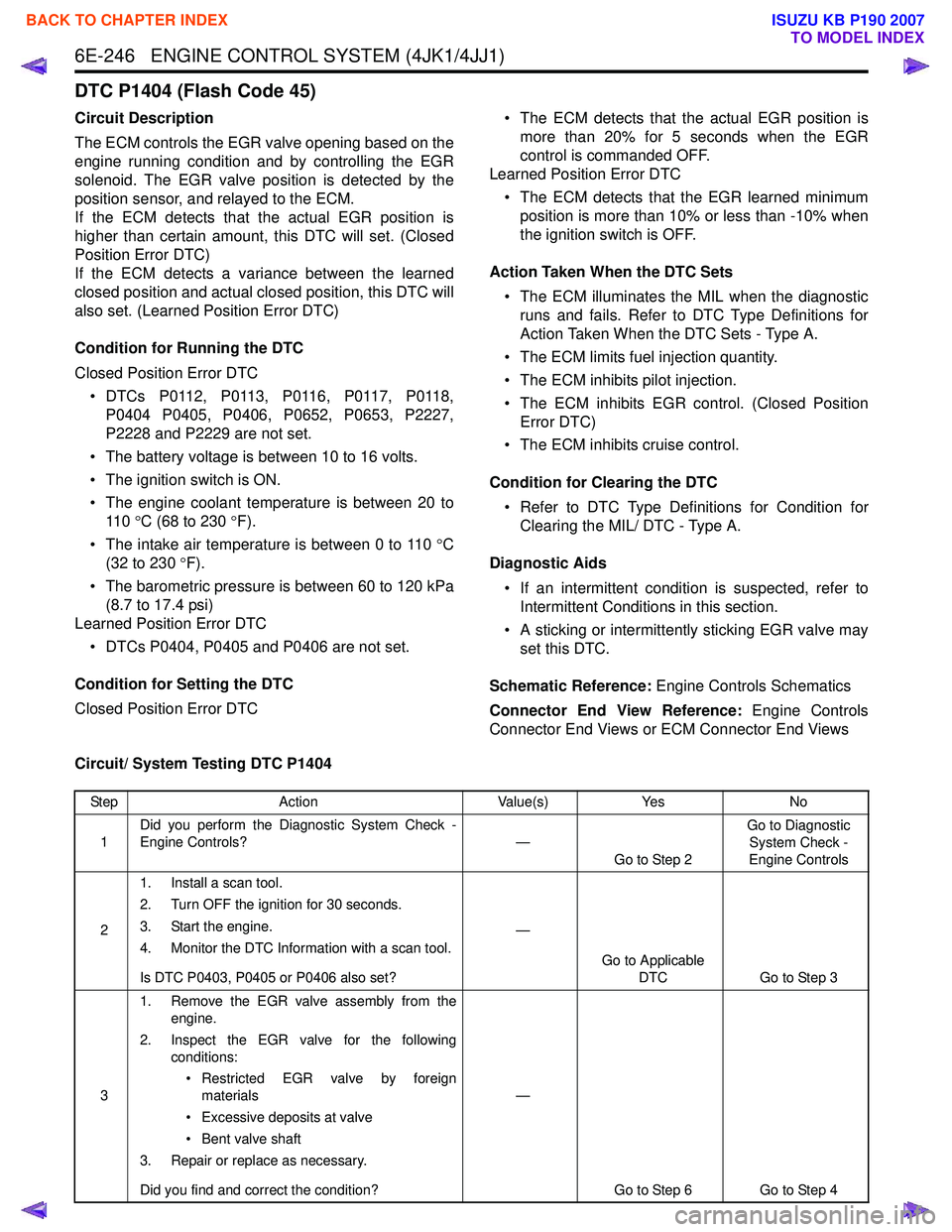
6E-246 ENGINE CONTROL SYSTEM (4JK1/4JJ1)
DTC P1404 (Flash Code 45)
Circuit Description
The ECM controls the EGR valve opening based on the
engine running condition and by controlling the EGR
solenoid. The EGR valve position is detected by the
position sensor, and relayed to the ECM.
If the ECM detects that the actual EGR position is
higher than certain amount, this DTC will set. (Closed
Position Error DTC)
If the ECM detects a variance between the learned
closed position and actual closed position, this DTC will
also set. (Learned Position Error DTC)
Condition for Running the DTC
Closed Position Error DTC • DTCs P0112, P0113, P0116, P0117, P0118, P0404 P0405, P0406, P0652, P0653, P2227,
P2228 and P2229 are not set.
• The battery voltage is between 10 to 16 volts.
• The ignition switch is ON.
• The engine coolant temperature is between 20 to 11 0 °C (68 to 230 °F).
• The intake air temperature is between 0 to 110 °C
(32 to 230 °F).
• The barometric pressure is between 60 to 120 kPa (8.7 to 17.4 psi)
Learned Position Error DTC
• DTCs P0404, P0405 and P0406 are not set.
Condition for Setting the DTC
Closed Position Error DTC • The ECM detects that the actual EGR position is
more than 20% for 5 seconds when the EGR
control is commanded OFF.
Learned Position Error DTC
• The ECM detects that the EGR learned minimum position is more than 10% or less than -10% when
the ignition switch is OFF.
Action Taken When the DTC Sets • The ECM illuminates the MIL when the diagnostic runs and fails. Refer to DTC Type Definitions for
Action Taken When the DTC Sets - Type A.
• The ECM limits fuel injection quantity.
• The ECM inhibits pilot injection.
• The ECM inhibits EGR control. (Closed Position Error DTC)
• The ECM inhibits cruise control.
Condition for Clearing the DTC • Refer to DTC Type Definitions for Condition for Clearing the MIL/ DTC - Type A.
Diagnostic Aids • If an intermittent condition is suspected, refer to Intermittent Conditions in this section.
• A sticking or intermittently sticking EGR valve may set this DTC.
Schematic Reference: Engine Controls Schematics
Connector End View Reference: Engine Controls
Connector End Views or ECM Connector End Views
Circuit/ System Testing DTC P1404
Step Action Value(s)Yes No
1 Did you perform the Diagnostic System Check -
Engine Controls? —
Go to Step 2 Go to Diagnostic
System Check -
Engine Controls
2 1. Install a scan tool.
2. Turn OFF the ignition for 30 seconds.
3. Start the engine.
4. Monitor the DTC Information with a scan tool.
Is DTC P0403, P0405 or P0406 also set? —
Go to Applicable DTC Go to Step 3
3 1. Remove the EGR valve assembly from the
engine.
2. Inspect the EGR valve for the following conditions:
• Restricted EGR valve by foreign materials
• Excessive deposits at valve
• Bent valve shaft
3. Repair or replace as necessary.
Did you find and correct the condition? —
Go to Step 6 Go to Step 4
BACK TO CHAPTER INDEX
TO MODEL INDEX
ISUZU KB P190 2007
Page 1864 of 6020

ENGINE CONTROL SYSTEM (4JK1/4JJ1) 6E-247
41. Turn OFF the ignition.
2. Disconnect the EGR valve harness connector.
3. Inspect for an intermittent, for poor connections and corrosion at the harness
connector of the EGR valve (pins 1, 2, 3, 4
and 6 of E-71).
4. Disconnect the ECM harness connector.
5. Inspect for an intermittent, for poor connections and corrosion at the harness
connector of the ECM (pins 30, 31, 32, 62 and
63 of E-90).
6. Test for high resistance on each circuit.
7. Repair the connection(s) or circuit(s) as necessary.
Did you find and correct the condition? —
Go to Step 6 Go to Step 5
5 Replace the EGR valve. Refer to EGR Valve
Replacement.
Did you complete the replacement? —
Go to Step 6
—
61. Reconnect all previously disconnected
harness connector(s).
Notice: Ignition switch must be cycled before clear
the DTC.
2. Turn ON the ignition, with the engine OFF.
3. Turn OFF the ignition for 30 seconds.
4. Turn ON the ignition and clear the DTCs with a scan tool.
5. Turn OFF the ignition for 30 seconds.
6. Start the engine.
7. Operate the vehicle within the Conditions for Running the DTC. You may also operate the
vehicle within the conditions that you
observed from the Freeze Frame/ Failure
Records.
Did the DTC fail this ignition? —
Go to Step 2 Go to Step 7
7 Observe the DTC Information with a scan tool.
Are there any DTCs that you have not diagnosed? —
Go to DTC List System OK
Step
Action Value(s)Yes No
BACK TO CHAPTER INDEX
TO MODEL INDEX
ISUZU KB P190 2007
Page 1865 of 6020
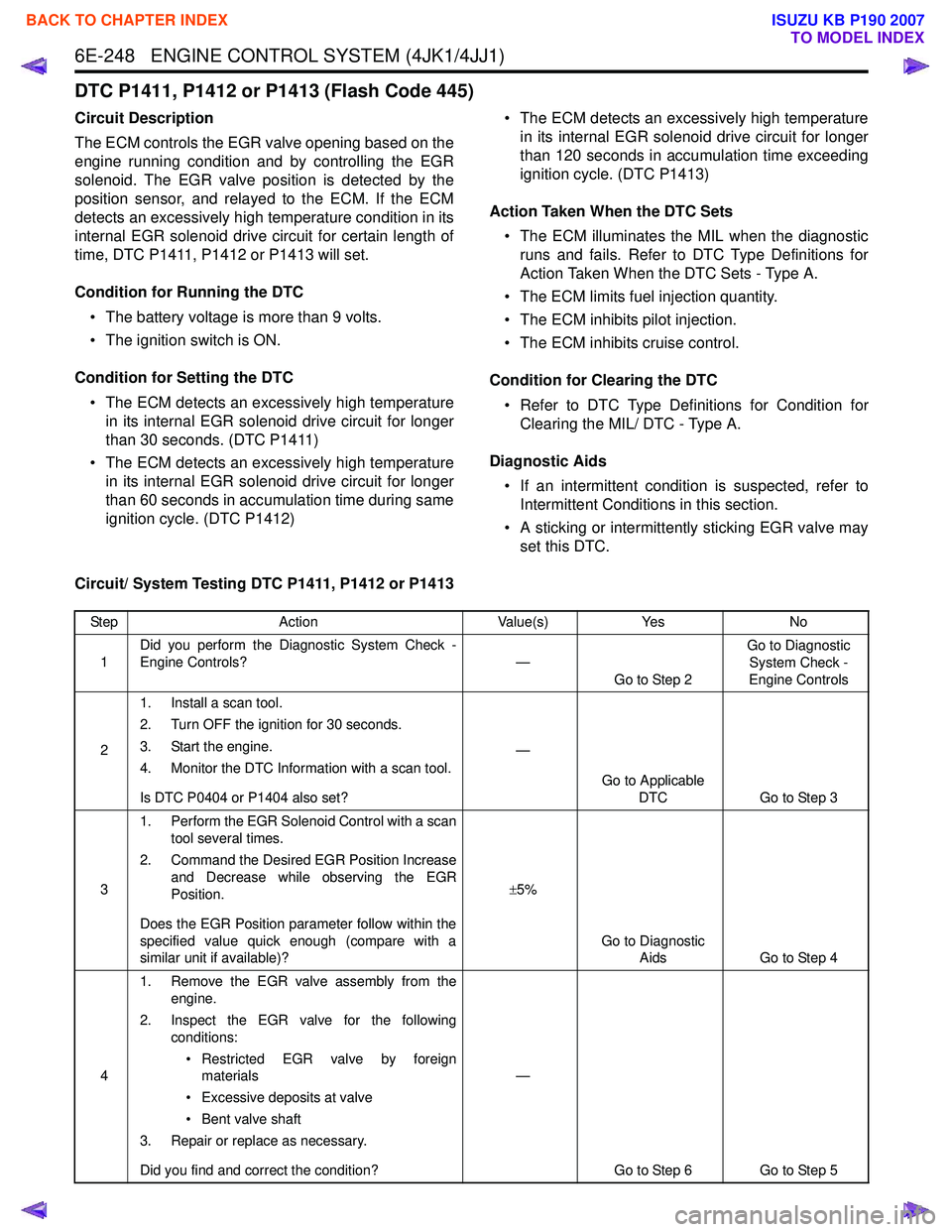
6E-248 ENGINE CONTROL SYSTEM (4JK1/4JJ1)
DTC P1411, P1412 or P1413 (Flash Code 445)
Circuit Description
The ECM controls the EGR valve opening based on the
engine running condition and by controlling the EGR
solenoid. The EGR valve position is detected by the
position sensor, and relayed to the ECM. If the ECM
detects an excessively high temperature condition in its
internal EGR solenoid drive circuit for certain length of
time, DTC P1411, P1412 or P1413 will set.
Condition for Running the DTC • The battery voltage is more than 9 volts.
• The ignition switch is ON.
Condition for Setting the DTC • The ECM detects an excessively high temperature in its internal EGR solenoid drive circuit for longer
than 30 seconds. (DTC P1411)
• The ECM detects an excessively high temperature in its internal EGR solenoid drive circuit for longer
than 60 seconds in accumulation time during same
ignition cycle. (DTC P1412) • The ECM detects an excessively high temperature
in its internal EGR solenoid drive circuit for longer
than 120 seconds in accumulation time exceeding
ignition cycle. (DTC P1413)
Action Taken When the DTC Sets • The ECM illuminates the MIL when the diagnostic runs and fails. Refer to DTC Type Definitions for
Action Taken When the DTC Sets - Type A.
• The ECM limits fuel injection quantity.
• The ECM inhibits pilot injection.
• The ECM inhibits cruise control.
Condition for Clearing the DTC • Refer to DTC Type Definitions for Condition for Clearing the MIL/ DTC - Type A.
Diagnostic Aids • If an intermittent condition is suspected, refer to Intermittent Conditions in this section.
• A sticking or intermittently sticking EGR valve may set this DTC.
Circuit/ System Testing DTC P1411, P1412 or P1413
Step Action Value(s)Yes No
1 Did you perform the Diagnostic System Check -
Engine Controls? —
Go to Step 2 Go to Diagnostic
System Check -
Engine Controls
2 1. Install a scan tool.
2. Turn OFF the ignition for 30 seconds.
3. Start the engine.
4. Monitor the DTC Information with a scan tool.
Is DTC P0404 or P1404 also set? —
Go to Applicable DTC Go to Step 3
3 1. Perform the EGR Solenoid Control with a scan
tool several times.
2. Command the Desired EGR Position Increase and Decrease while observing the EGR
Position.
Does the EGR Position parameter follow within the
specified value quick enough (compare with a
similar unit if available)? ±
5%
Go to Diagnostic Aids Go to Step 4
4 1. Remove the EGR valve assembly from the
engine.
2. Inspect the EGR valve for the following conditions:
• Restricted EGR valve by foreign materials
• Excessive deposits at valve
• Bent valve shaft
3. Repair or replace as necessary.
Did you find and correct the condition? —
Go to Step 6 Go to Step 5
BACK TO CHAPTER INDEX
TO MODEL INDEX
ISUZU KB P190 2007